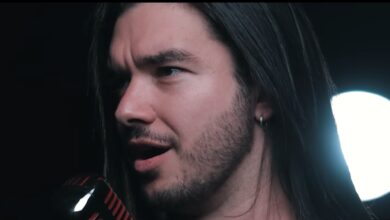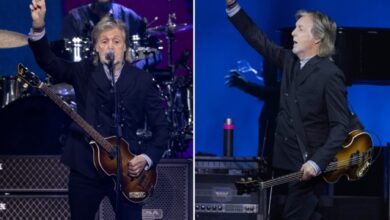Erik Grönwall’s “O Holy Night”: A Triumphant Christmas Masterpiece That Blends Faith, Resilience, and Rock Soul into Something Truly Magical
The moment arrived like a burst of light in the dark of winter. Erik Grönwall, the dynamic Swedish vocalist famed for his Idol victory in 2009, his electrifying work with H.E.A.T, and his later tenure with Skid Row, unveiled a deeply moving version of “O Holy Night.” Filmed within a dimly lit church glowing with candles, the performance went beyond a seasonal gesture—it became an expression of gratitude and renewal. For an artist who built his reputation on high-octane energy, this was a shift toward a gentler, spiritual force—one filled with calm intensity and heartfelt sincerity in every note.
Those who followed him closely sensed something remarkable on the horizon. In early December 2024, subtle teasers hinted at a release scheduled for Friday, December 13 at 5 p.m. CET. The project, filmed with the approval of Alunda Församling parish, promised authenticity over artifice. Rather than the sterile perfection of a recording studio, this rendition embraced the natural echo of sacred walls. When it finally premiered, the first images—candles flickering, the church bathed in amber light, and Erik’s voice soaring into the stillness—captured hearts instantly.
The arrangement’s strength lies in its restraint. Grönwall begins softly, as though whispering a prayer into the silence, giving space for each word to breathe. As the verses unfold, the song swells with emotional gravity, moving from quiet reverence to explosive majesty. His voice blooms with strength and control, every high note radiating conviction without a trace of strain. This precision reveals his years of experience performing rock anthems—yet here, that same discipline serves a higher emotional purpose rather than spectacle.
To understand the depth of the performance, one must recall his journey. In 2021, Grönwall faced a life-altering leukemia diagnosis, underwent a bone marrow transplant, and miraculously recovered. His comeback inspired countless fans who admired his courage. After joining Skid Row in 2022 and later stepping back for health reasons, he redirected his focus inward. This performance of “O Holy Night” became a reflection of his survival—a musical testimony of faith, gratitude, and human resilience embodied through sound.
The visuals convey that transformation beautifully. There are no flashing lights or elaborate sets—only the soft flicker of candle flames illuminating wood and stone. The cinematography relies on long, contemplative shots that follow his expression rather than chase visual drama. The camera draws near only at the emotional peak, capturing the quiet shimmer of tears in his eyes. The simplicity makes the moment feel sacred, proving that genuine emotion can speak louder than any extravagant production ever could.
Within days of release, the video became a sensation. View counts climbed rapidly, reaching hundreds of thousands almost overnight. But it wasn’t algorithms driving the momentum—it was the human impulse to share something beautiful. People who typically posted about guitars and riffs were suddenly sharing a Christmas hymn. Erik later revealed that the video had surpassed 100,000 daily views and announced plans to release the single on streaming platforms for fans eager to carry its spirit beyond YouTube.
The power of the performance comes from its equilibrium between might and humility. His voice carries the weight of rock yet never overshadows the sanctity of the message. The pauses between verses are as meaningful as the notes themselves, creating space for reflection. When his full range finally bursts forth in the climactic chorus, it doesn’t sound like display—it feels like release, a prayer turned into sound. The result is both cinematic and intimate, bridging heaven and earth with music.
The audience reaction confirmed its emotional reach. Vocal experts analyzed the performance, admiring his breath management and ease across registers. Longtime rock listeners praised the conviction, while spiritual viewers recognized the sincerity of tone. Across thousands of comments, one phrase appeared again and again: “goosebumps.” It was one of those rare internet moments when fans from different worlds agreed that a performance had managed to transcend category and expectation—it simply felt divine.
The sacred setting elevated its emotional truth. Unlike staged studio renditions, this one thrived within a living church. The natural reverb of the sanctuary acted as a collaborator, allowing every syllable to shimmer and resonate through ancient walls. When the last note faded, silence itself became part of the music—a shared breath between performer and listener. The sound’s raw purity, untouched by studio polish, made the entire piece feel like a living, breathing prayer.
The song also serves as a personal milestone. Before fame, Grönwall sang in choirs, finding joy in collective harmony before stepping into the spotlight. Years of rock stardom amplified his voice but distanced him from that spiritual simplicity. After surviving illness, he rediscovered that early purity. “O Holy Night” thus becomes a reunion with his younger self—a fusion of the boy who once sang in church and the man who conquered global stages, now united in purpose and grace.
From a technical standpoint, the performance borders on perfection. Grönwall shapes his vowels for maximum resonance, his tone open and unforced even at peak intensity. The breath control required to sustain the climactic “divine” would challenge most vocalists, yet he executes it with serenity. Every phrase carries intentionality, as though sculpted from silence itself. It’s a demonstration of mastery, discipline, and deep emotional connection woven into one seamless act of expression.
Visually, the subtleties tell their own story. A faint smile before the final verse, a brief gaze upward as if in quiet thanks, the exhale after the final note—all these moments create an unspoken dialogue between the artist and something higher. Nothing feels rehearsed. The performance reads like a confession of gratitude rather than a showcase. In an age where perfection often feels synthetic, his vulnerability feels revolutionary, restoring authenticity to performance art.
The release strategy was as smart as it was heartfelt. By premiering in mid-December, the video captured the height of Christmas emotion, while later releasing it across platforms ensured longevity. Each winter, the track resurfaces, spreading anew through playlists and social feeds. Fans repeatedly call it a “tradition in motion.” More than a seasonal hit, it has become a yearly ritual—proof that genuine artistry, once born, continues to live long after its debut moment fades.
For audiences in Scandinavia, the project held extra significance. The song, known in Swedish as “O Helga Natt,” has deep cultural roots in Nordic holiday celebrations. Recording it in a Swedish church imbued the rendition with authenticity, connecting modern viewers to centuries of tradition. Yet by performing it in English, Grönwall extended that heritage globally. The fusion of Nordic serenity and rock passion created something universal—an anthem that speaks to the human spirit regardless of language or faith.
Ultimately, “O Holy Night” captures the essence of redemption through art. It reflects the triumph of life over illness, humility over ego, and purpose over performance. When Grönwall reaches the final crescendo, his voice embodies gratitude and survival intertwined. It’s not simply a song—it’s a resurrection in melody, a reminder that even the loudest rock hearts can find stillness when they sing for something greater than themselves. The moment he sings “divine,” you feel it—not just in your ears, but in your soul.
Each holiday season, new listeners stumble upon the video and stay transfixed until the end. Others revisit it each year, as one might relight a familiar candle. What began as a performance has transformed into a personal tradition for many—a ritual of reflection and gratitude. Erik Grönwall didn’t merely reinterpret “O Holy Night”; he redefined how a song can heal, uplift, and remind us that beauty often emerges from our deepest struggles.
His artistic reach extends beyond this hymn. Before it, Grönwall delivered a striking rendition of Mariah Carey’s “Without You,” turning a soft pop ballad into a powerhouse display of rock emotion. His vocal range blended raw strength with tenderness, proving that vulnerability and power could coexist within one breath. Listeners praised his ability to elevate familiar melodies into fresh emotional landscapes, reinforcing his reputation as one of the most versatile vocalists of his generation.
He later revisited another vocal mountain—Whitney Houston’s “I Will Always Love You.” Stripping away glossy production, he delivered it with raw, rock-infused emotion. Each phrase carried both control and fragility, honoring the original while redefining it through his own spirit. The pairing of these songs with “O Holy Night” forms a powerful triptych of artistry—each one revealing another side of his soul. Through them all, Erik Grönwall proves that when passion meets authenticity, music becomes something eternal.





